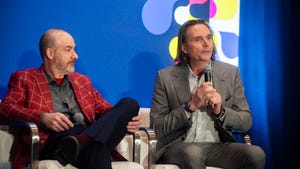The Life Monochrome: The U.K.'s Digital Laggards
Government plans to save money -- and generate revenue -- by shifting citizen services online may be derailed by people with no interest in smartphones, computers or even color TV.

There are two faces to the United Kingdom's enthusiastic embrace of the digital life. On the one hand, new figures show that the U.K. market for cellphone service is the most competitive in Europe, with 60% of the population using smartphones, and 20% being regular tablet users.
And on the other hand, who can resist being surprised that, in the country that was the first to deploy 3G mobile to its citizens, some 13,202 TVs in use today are -- not merely analog or three-color cathode ray -- black and white. To put this in context, 12 years ago there were still 212,000 B&W TVs being used.
How do we know that, in the country that in October proudly finished a five-year transition to all TV signals being sent digitally, that those B&W sets are still being regularly switched on and off? By the same factor that likely explains the existence of these antiquated sets: money. In the U.K., to own any kind of TV set means paying a special TV license tax. In the current year, most TV sets, no matter how high end, cost a flat rate of $233 (or £145), while the humbler monochrome option will only set your household back $79 (£49), a third of the price. (It sounds like a poor joke, but you get a 50% rebate if you have challenges with your sight, and it's free from age 75 on.)
It's unclear whether these citizens receive the HD material the BBC transmits, let alone some of the 3-D programming its satellite rival Sky schedules. And presumably, such remarkably conservative consumers can't be that interested in using their sets to vote in real time in reality TV shows and the like.
[ Consumer tech is hot, in spite of the digital laggards. See CES 2013: 7 Standout Technologies . ]
The real issue here, though, isn't so much parsimonious Brits not wanting to pay to watch modern television, let alone watch in the non-linear way we're all supposed to want to now. It's actually about the interesting divergence between the country's ambitions to be a fully information age nation and the reality. For example, according to state telecommunications regulator Ofcom, national average broadband speed is a pretty average 7.6 Mbps. The same organization revealed this week that the majority of Brits have almost no interest in 4G LTE, with 68% saying they were happy with what they had. Note that 4G is happening because the government hopes to raise $8.5 billion (£5.3 billion) by selling off the spectrum now available because it no longer carries analog TV to those black and white die-hards. If the government doesn't end up with that windfall, economic plans to curb the country's deficit will be negatively impacted.
This disparity is also, of course, about social inequality. Official government figures regularly report that 16% of the population has never been online -- ever. This could be something of a challenge for a state that, in order to save money, is deliberately moving to a "digital by default" position on interacting with all users of its services.
The issue of what used to be called the digital divide, but which is now styled "digital inclusion," is taken seriously in the United Kingdom. The government, for instance, has supported the work of the Digital Inclusion Task Force, a pro bono organization headed by the former poster girl for the country's dot-com era, Martha Lane Fox. Its data suggests 6 million Brits find themselves both "socially and digitally excluded," a group largely comprised of the lowest income citizens, some ethnic minorities and, especially, the elderly. The 13,000 black-and-white TV owners are, in all probability, almost all in this cohort. That is, they are not eccentrics who dislike "the modern," but people the Task Force styles as those who could easily benefit from technology to help address their poverty and social isolation, help with health challenges, and enable them to live more independent lives in their communities.
But until these groups start seeing any point in any kind of broadband, let alone superfast, they will probably stick to their old way of life -- which includes ancient TVs, it seems.
About the Author(s)
You May Also Like
Generative AI: Use Cases and Risks in 2024
May 29, 2024Smart Service Management
June 4, 2024Tales of a Modern Data Breach: The Rise of Mobile Attacks
June 11, 2024







